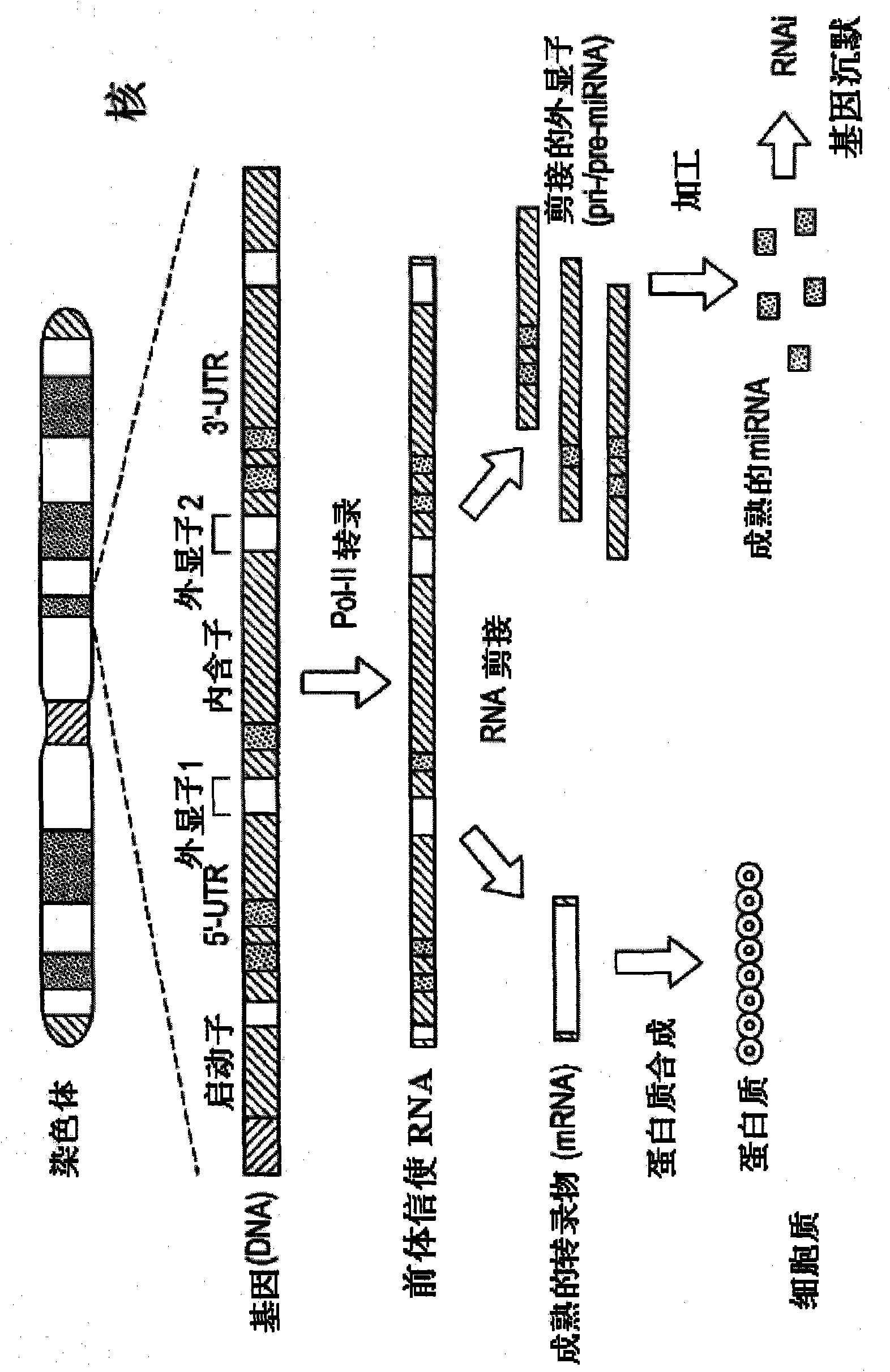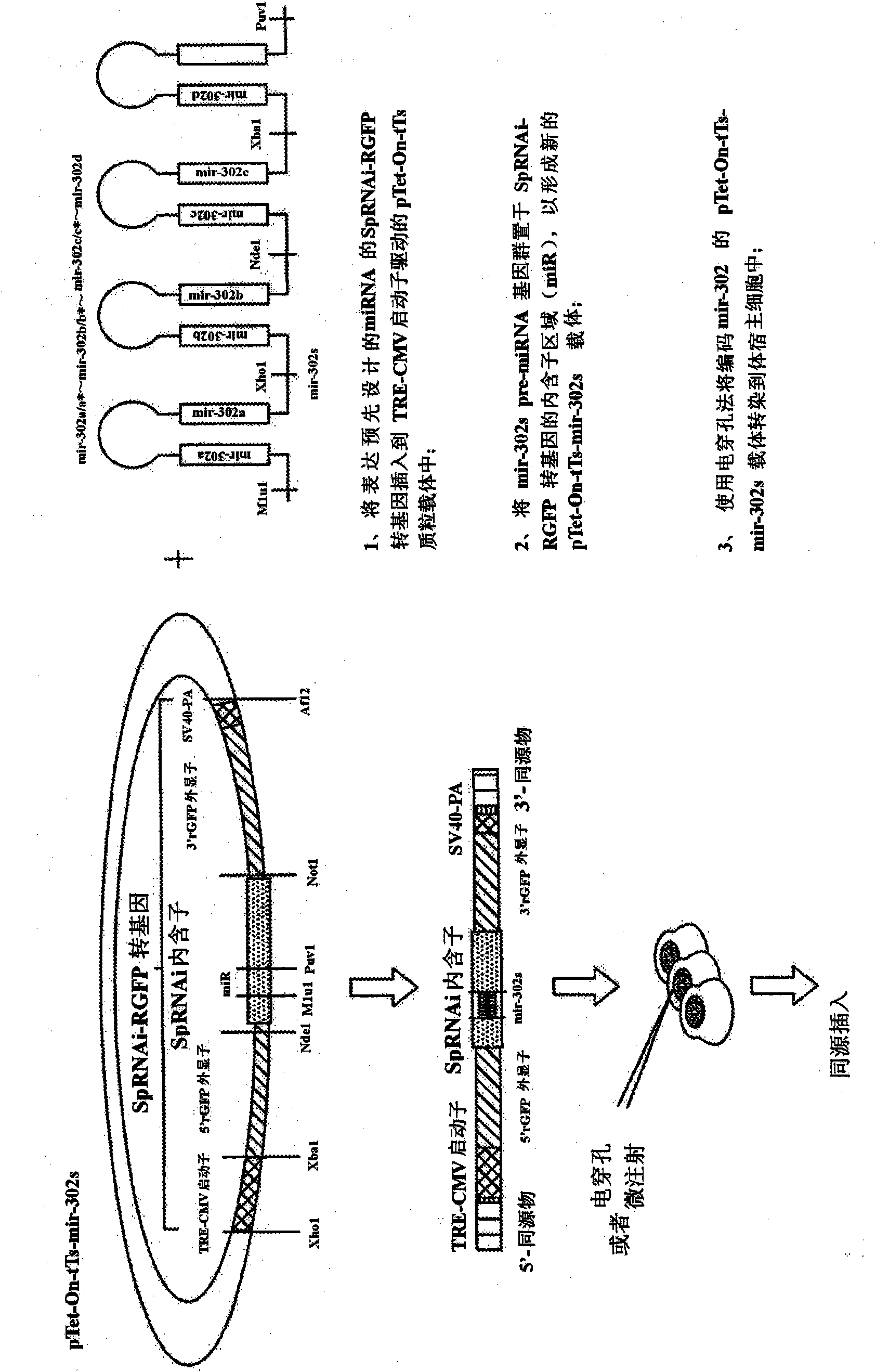Generation of tumor-free embryonic stem-like pluripotent cells using inducible recombinant RNA agents
A technology of recombinant nucleic acid and pluripotent stem cells, which is applied in the field of pluripotent cells that use inducible recombinant ribonucleic acid factors to generate tumor-free embryonic stem cells, and can solve the problems of undetermined overall developmental signals
- Summary
- Abstract
- Description
- Claims
- Application Information
AI Technical Summary
Problems solved by technology
Method used
Image
Examples
Embodiment 2
[0046] The present inventors took advantage of the intracellular spliceosome, exosome and NMD system to catalyze the release of intronic mir-302 miRNA / shRNA factors from the SpRNAi-RGFP transgene. In Example 1 and Figure 2A and Figure 2B The sequence DNA recombination [for example: snRNPs U1, U2 and U4 / U6. U5tri-snRNP required by the sequence DNA recombination of the splice body components in the several snRNP recognition positions of the SpRNAi is described in it, and it comprises: 5' end splice site (SEQ.ID.NO.4), branch point motif (BrP; SEQ.ID.NO.6), polypyrimidine string (PPT; SEQ.ID.NO.7 or SEQ.ID.NO .8), and the 3' end splice site (SEQ.ID.NO.5)], used to assemble the synthetic snRNP recognition element into the SpRNAi intron and incorporate this artificially recombined SpRNAi into the isolated inducible RGFP gene To form the method for the SpRNAi-RGFP transgene. In addition, the SpRNAi further comprises an intron insertion site located between the 5' end splice sit...
Embodiment 1
[0147] Constructs comprising the SpRNAi recombinant RGFP gene (SpRNAi-RGFP)
[0148] Synthetic oligonucleotides used to generate SpRNAi introns containing sense, antisense, or hairpin EGFP inserts are listed below: sense N1,5'-GTAAGAGGATCCGATCGCAG GAGCGCACCA TCTTCTTCAA GA-3' (SEQ.ID.NO. 14); antisense N1, 5'-CGCGTCTTGA AGAAGATGGT GCGCTCCTGC GATCGG-ATCC TCTTAC-3' (SEQ.ID.NO.15); sense N2, 5'-GTAAGAGGATCCGATCGCTT GAAGAAGATG GTGCGCTCCT GA-3' (SEQ.ID.NO. 16); antisense N2, 5'-CGCGTCAGGA GCGCACCATC TTCTTCAAGCGATCGGATCC TCTTAC-3' (SEQ.ID.NO.17); sense N3, 5'-GTAAGAGGATCCGATCGCAG GAGCGCACCA TCTTCTTCAA GTTAACTTGAAGAAGATGGT GCGCTCCTGA-3' (SEQ.ID.NO.18) ; Antisense N3, 5'-CGCGTCAGGA GCGCACCATC TTCTTCAAGT TAACTTGAAGAAGATGGTGC GCTCCTGCGA TCGGATCCTC TTAC-3' (SEQ.ID.NO.19); Sense N4, 5'-CGCGTTACTA ACTGGTACCTCTTCTTTTTT TTTTTGATAT CCTGCAG-3' (SEQ.ID.NO.20) ; Antisense N4, 5'-GTCCTGCAGG ATTCAAAAAAAAAAAGAAGAGGTACCAGTTAGTAA-3' (SEQ.ID.NO.21). All sequences listed from SEQ.ID.NO.14-SEQIDNO.21...
Embodiment 3
[0161] mir-302s cell culture and transgene delivery
[0162] Human cancer PC3 and Colo 829 cell lines were obtained from the American Culture Center (ATCC, Rockville, MD), while hHFC and hpESC cells were decomposed with collagenase / trypsin (4:1) to decompose 2 to 10 hair follicle roots or 2mm from hair or arm of the inventor 3 Prepared by explantation of the skin. at 37°C and 5% CO 2 These cells were cultured in RPMI 1640 medium supplemented with 10% fetal bovine serum (FBS), 4mM L-glutamine, 1mM sodium pyruvate and 100μg / ml gentamicin (Sigma Chemical, MO). Cultures were passaged at 70-80% confluency by exposing cells to trypsin-EDTA solution for 1 min and rinsing once in RPMI, and then re-plating these detached cells at a 1:10 dilution into fresh growth medium. For transgenic mir-302s delivery by electroporation, the pTet-On-tTS-mir302s vector (10-30 μg) was mixed with the host cells (200-2000 μg) in a hypotonic pH buffer (400 μl; microcentrifuge tube) Mixing, and ele...
PUM
 Login to View More
Login to View More Abstract
Description
Claims
Application Information
 Login to View More
Login to View More - R&D
- Intellectual Property
- Life Sciences
- Materials
- Tech Scout
- Unparalleled Data Quality
- Higher Quality Content
- 60% Fewer Hallucinations
Browse by: Latest US Patents, China's latest patents, Technical Efficacy Thesaurus, Application Domain, Technology Topic, Popular Technical Reports.
© 2025 PatSnap. All rights reserved.Legal|Privacy policy|Modern Slavery Act Transparency Statement|Sitemap|About US| Contact US: help@patsnap.com



